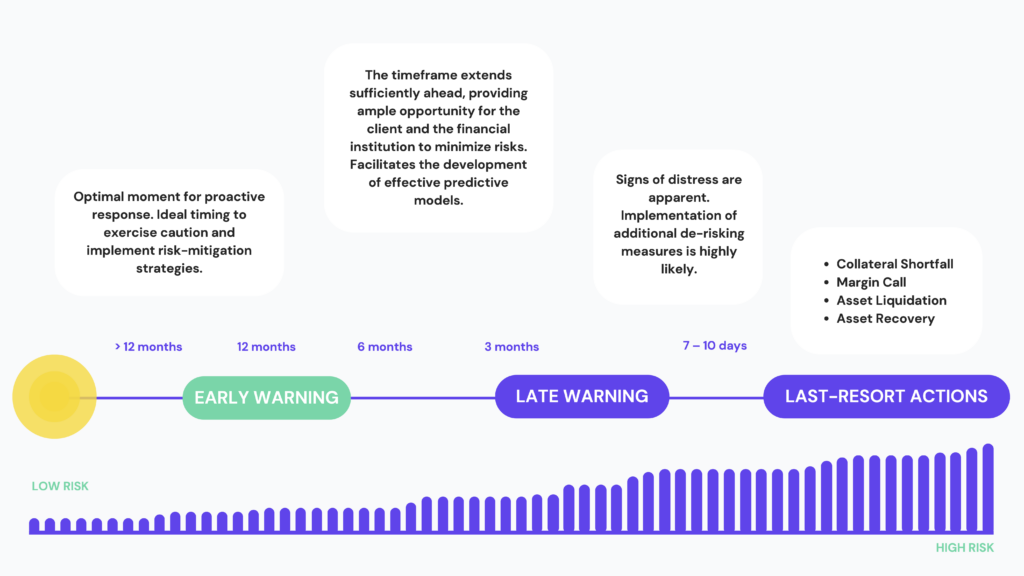5 min read
Future-Proofing Financial Institutions: The Power of Early Warning System Solutions in Risk Management

Early Warning Systems (EWS), as a cutting-edge technological solution poised to revolutionise traditional credit monitoring practices, Early Warning Systems serve as a crucial tool for identifying risks associated with biased or subjective decision-making, offering a proactive approach to predicting potential customer defaults on loans and other credit facilities.
In the past, banks relied on internal credit monitoring teams to scrutinise customer accounts to determine credit risk ratings and potential defaults. However, this approach required enhancements to include previously overlooked parameters that could act as triggers or red flags. Financial institutions have shifted from this approach and introduced EWS, particularly those based on rules, which can furnish both financial and non-financial indicators at both customer and industry levels. This new approach has facilitated the process to deliver a more comprehensive analysis as well as an early detection capability thus mitigating the associated risks.
An effective EWS not only identifies credit risks; it provides actionable triggers and suggests preemptive measures to be taken by financial institutions in advance of a potential default. The range of EWS can be extensive and tailored to meet the specific monitoring and regulatory needs of individual financial institutions. It can assist in customer segmentation, determine relevant financial and non-financial indicators, establish measurement criteria, generate triggers based on these indicators, and propose risk mitigation plans.
The benefits of implementing EWS are substantial. Analysts believe that had these systems been in place sooner, they could have foreseen major financial crises, such as the Lehman Brothers collapse and the subprime crisis, weeks or even months before they occurred.
In today’s volatile economic landscape, the integration of an automated EWS, enabled by AI and machine learning, is crucial for financial institutions to monitor and pinpoint delinquent loans or elevated credit risks. It should be seamlessly incorporated into ongoing portfolio monitoring activities, be it on an annual, quarterly, day-on-day, or event-driven basis, ensuring timely detection of distress indicators.
Regulatory bodies around the globe, such as the Saudi Central Bank and the European Banking Authority, have recognised the importance of EWS. Guidelines have been established to emphasise the development, maintenance, and regular evaluation of relevant quantitative and qualitative EWS to detect credit risks across portfolios, industries, geographies, and individual accounts.

At the forefront of financial operations, customer interactions, relationship management, and market engagement are key components of success. Early Warning Systems in the front end act as vigilant custodians, orchestrating proactive risk management strategies to ensure a seamless and secure client experience.
Holistic Risk Assessment and Client Relationship Management
- A bank can use a sophisticated EWS to analyse not just financial transactions but also public records and market trends to predict potential shifts in a client’s financial stability. This allows relationship managers to proactively engage with clients facing financial challenges, offering tailored solutions to prevent defaults.
Sentiment-Driven Market Intelligence
- An investment firm is capable of implementing EWS with sentiment analysis to monitor news articles and market forums. If negative sentiments arise around a particular stock, the system triggers alerts, enabling the firm to adjust investment strategies promptly and avoid potential losses.
On the backend, Early Warning Systems focus on operational processes, compliance adherence, fraud detection, and cybersecurity, contributing to the overall resilience and stability of financial institutions.
Dynamic Fraud Detection and Prevention
- An e-commerce platform could integrate EWS with machine learning algorithms for fraud detection. The system analyses user behaviour patterns and identifies anomalies, such as unusual transaction volumes or atypical purchasing locations, allowing the platform to prevent fraudulent activities in real time.
Comprehensive Compliance Monitoring
- A financial institution uses EWS equipped with natural language processing to stay abreast of evolving regulatory requirements. The system not only monitors media sentiments but also interprets regulatory changes, ensuring the institution’s compliance officers can swiftly implement necessary adjustments to policies and procedures.
Contextual Cybersecurity Measures
- A bank employs backend EWS with behavioural analytics to enhance cybersecurity. The system establishes a baseline of normal media behaviours, and if news articles suddenly exhibit unusual patterns, such as accessing sensitive data during non-business hours, the system triggers alerts, allowing the cybersecurity team to investigate and respond promptly.
To that end, and leveraging cutting-edge artificial intelligence, natural language processing, and machine learning technologies, Semantic Visions, through its AI/ML refined and accurate global news datasets, provides datasets that seamlessly integrate with and complement financial institutions’ existing risk management infrastructure. Our client-focused approach allows for a smooth implementation process, ensuring minimal disruption to ongoing operations.
Our data offers both financial and non-financial indicators, assisting a proactive and comprehensive approach to predicting high-risk customers and potential defaults. Moreover, it accommodates the institutions in segmenting customers, determining relevant indicators, and generating actionable triggers for risk mitigation.
As regulatory bodies increasingly emphasise the importance of risk monitoring, Semantic Visions emerges as a reliable and efficient solution, contributing to the secure and resilient financial landscape, and improving robust risk management capabilities.
In conclusion, EWS plays a crucial role in contemporary risk management. In the financial sector, Semantic Visions provides a solution that complements traditional credit monitoring practices. Driven by artificial intelligence and machine learning, their datasets allow clients to better identify risks, create scenarios, and propose risk mitigation plans. In a landscape where efficiency in risk and regulatory compliance is essential, Semantic Visions emerges as a contributing factor for a secure and resilient financial environment.





